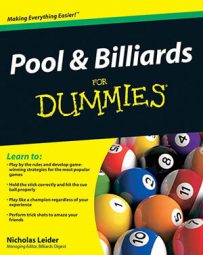Know what to look for in a cue stick
Love to play pool so much that you’re in the market for your own cue stick? You’ll need to address these points to ensure you get the cue stick that helps you excel in your pool game.
-
Tip: The tip is the most important part of a cue. Tips vary from soft to hard, though inexperienced pool players are best served with a medium to medium-soft tip.
-
Cue length: Most cues are 58 inches, but don’t be afraid to ask for a longer or shorter cue stick based on your body type.
-
Shaft material: The shaft of the cue — the end that hits the cue ball — can be made of fiberglass, graphite, or a wide array of woods. If you can get a quality maple shaft for a price that works, go for the natural feel.
-
Wrap: Most cues have a wrap near the butt (back end) to prevent your grip hand from slipping. Choose from a wide array of wraps, all based on personal preference.
-
Shaft taper: For your first cue, try to find a shaft with a shorter pro-taper (the shaft starts to taper at a point farther from the tip instead of immediately) so that you’ll have an easier transition from the shape of house cues to your own cue.
-
Joint: You screw a two-piece cue together at the joint, which can be made of metal, wood, or plastic. Two-piece cues (cues with a joint) can be rather inexpensive and generally an improvement from one-piece house cues.
Choose the correct-size pool table
A pool table is a great addition to the family game room, finished basement, or anywhere you gather. But you have to be a smart shopper when shopping for your own pool table. Having enough space is an absolute must, so here’s a chart to help you purchase the right-size table for the available space. Simply find your room size to find out what table size and cue are appropriate.
| Table Size (Feet) | 48-Inch Cue | 52-Inch Cue | 58-Inch Cue |
|---|---|---|---|
| 7 | 11’3″ x 14’6″ | 11’11” x 15’2″ | 12’9″ x 16′ |
| 8 | 11’8 x 15’4″ | 12’4″ x 16′ | 13’2″ x 16’10” |
| 8 (oversized) | 11’10” x 15’8″ | 12’6″ x 16’4″ | 13’4″ x 17’20” |
| 9 | 12’2″ x 14’4″ | 12’10” x 17′ | 13’8″ x 17’10” |
Master the fundamentals of a pool stroke
You need to check your pool stroke to make sure you’re on the path to becoming a fundamentally sound pool player. When you do check your stroke, ask yourself the following questions. (Hint: If you don’t answer all the questions with a yes, you should!)
-
Back arm: Are you stroking the cue moving only your back arm from the forearm down? Are you keeping your rear shoulder and elbow still and on the shot line for the entirety of your stroke?
-
Balanced stance: Are your feet a little wider than shoulder-width apart? Are your feet aligned at an angle (45 degrees is a good start) from your cue (and the line of your shot)?
-
Bridge: Do you have a strong, sturdy bridge that will not move immediately before, during, and after you stroke the cue? Do you have a bit of body weight on your bridge hand to help plant it on the table?
-
Eyes: During your practice strokes, are you moving your eyes from the contact point on the cue ball to the spot you’re aiming at on the object ball? When you take your final swing, are you locked in to the aiming point on the object ball?
-
Follow-through: Are you following through the cue ball by at least 6 inches? Are you gradually slowing the cue to a stop?
-
Grip hand: Is the back end of the cue resting gently on your fingers? Are you stroking the cue without tensing up and gripping the cue tightly?
-
Stroke: Are you using a controlled, slow backswing? Is the cue accelerating toward the cue ball?
Make the most of pool and billiards practice
To become a skilled pool player, you need to practice your game. The following tips help you get the most out of your pool practice sessions.
-
Stay fresh: Take quick breaks every 20 or 30 minutes to avoid brainlessly running through drills.
-
Focus: Distractions are everywhere — TV, friends, adult beverages, and so on — but if you want to get the most from your time, take 30 minutes to really focus.
-
Get warm: Take some time to loosen up. Start by just casually pocketing some balls, concentrating more on feeling comfortable and less on results.
-
Stay objective: Stay on an even keel. Try not to get too confident or too frustrated when you practice.
-
Improvise: Drills help, and exercises are good for you, but don’t be afraid to switch things up. If you want to create different ways to work on specific things, try something new.
-
End on a positive: Make the last shot or last few shots you take. It sounds simple, but ending on a high note will leave you feeling good as you leave the table.

